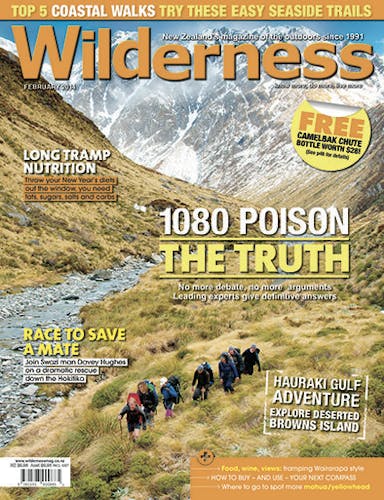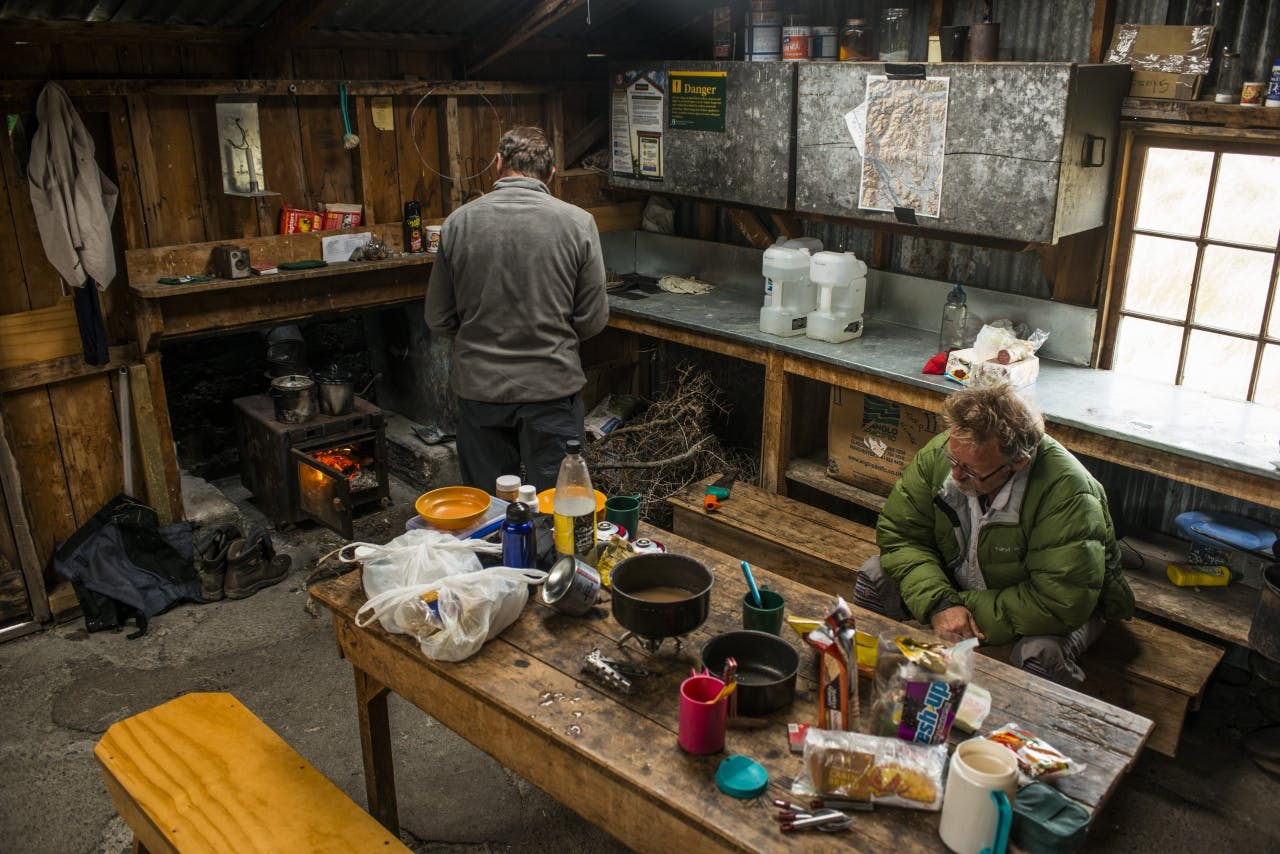Weight watchers demonise them in everyday life, but in the backcountry fatty, sugary and salty foods are the difference to plodding along and blitzing the track brim-full of enthusiasm and energy
Mashed potatoes and peas, instant pasta packets and two minute noodles – it’s the downside of multi-day tramps, right?
For some people, eating while tramping is a joyless experience; simply a matter of refuelling for the next day. But good kai has a way of boosting your spirits and energy levels, often when you need it most, and can lift an outdoor adventure from the great, to the sublime.
If you haven’t moved on from chowing down tasteless instant mashed potatoes and pasta then you may not only be filling up with second-rate fuel, but missing out on a culinary experience.
Sure, a curry cooked at home with fresh meat and vegetables is always going to be better than anything you can produce using dehydrated and dried foods. But factor in some mountain air, expansive views of the valley you’ve spent all day trudging up, a glorious sunset colouring the surrounding peaks and the satisfaction of pulling together a one-billy meal on a gas stove, and that backcountry curry might just be the best thing you’ve ever tasted.
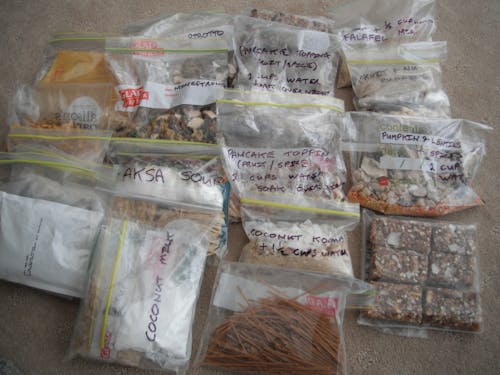
Pre-measuring, bagging and labelling meals makes life a lot easier for the backcountry chef. Photo: Paul Garland
When it comes to packing for multi-day tramps, balancing good food against weight restrictions is always a challenge, but long tramps are still no excuse for not eating well in the hills.
Keen tramper and author Paul Garland spent 152 days tramping the Te Araroa Trail, sometimes going 14 days at a stretch before he could re-stock, and he looked forward to every meal he ate.
In fact, he was so dismayed at seeing what other people ate at the huts he stayed in, while he dined like a king, it inspired him to write a tramping food cookbook.
Aged 68, he was passing people on the tracks less than half his age. To him, it seemed obvious that what they were eating just wasn’t giving them enough energy to walk for eight hours a day.
“You have no idea of the rubbish people eat,” Garland says. “A lot of backpackers, they live on noodles, couscous – those that have discovered couscous – and packets of soup. Then they moan they’re so tired they can hardly move from one hut to the next.”
One of the biggest complaints heard about tramping food is that it is all the same, but with a little thought, imagination and passion there is no reason why everybody can’t become a back country chef of sorts.
Garland, who dedicated his book to fellow trampers who love their food as much as they love their adventures, says tramping food shouldn’t be just about eating enough to keep you going, but a part of enjoying the whole outdoor experience.
Estimates of how much food a person needs per day when tramping, ranges from 600g-1000g. For a weeklong tramp, that’s anything from 4.2kg to 7kg, so you want to make sure the foods you choose have a high energy and nutritional value for their weight. Low fat, low sugar and low salt foods are definitely off the menu.
On multi-day tramps your body will need some protein to repair wear and tear of muscles, energy-dense fats to power low-to-moderate intensity exercise and plenty of carbohydrates for faster-burning energy.
Proteins don’t just provide the essential building blocks for muscle repair, they are also associated with increased satiation and reduced hunger. Think about meats, nuts, dairy products and lentils. For the first few days, meats such as salamis, bacon, chorizo and small tins of salmon or fish might be good options. Chicken or beef mince can be easily cooked and dehydrated – which is easy to do even if you don’t own a dehydrator. Lentils are lightweight but take a while to cook, however cooked lentils dehydrate well.
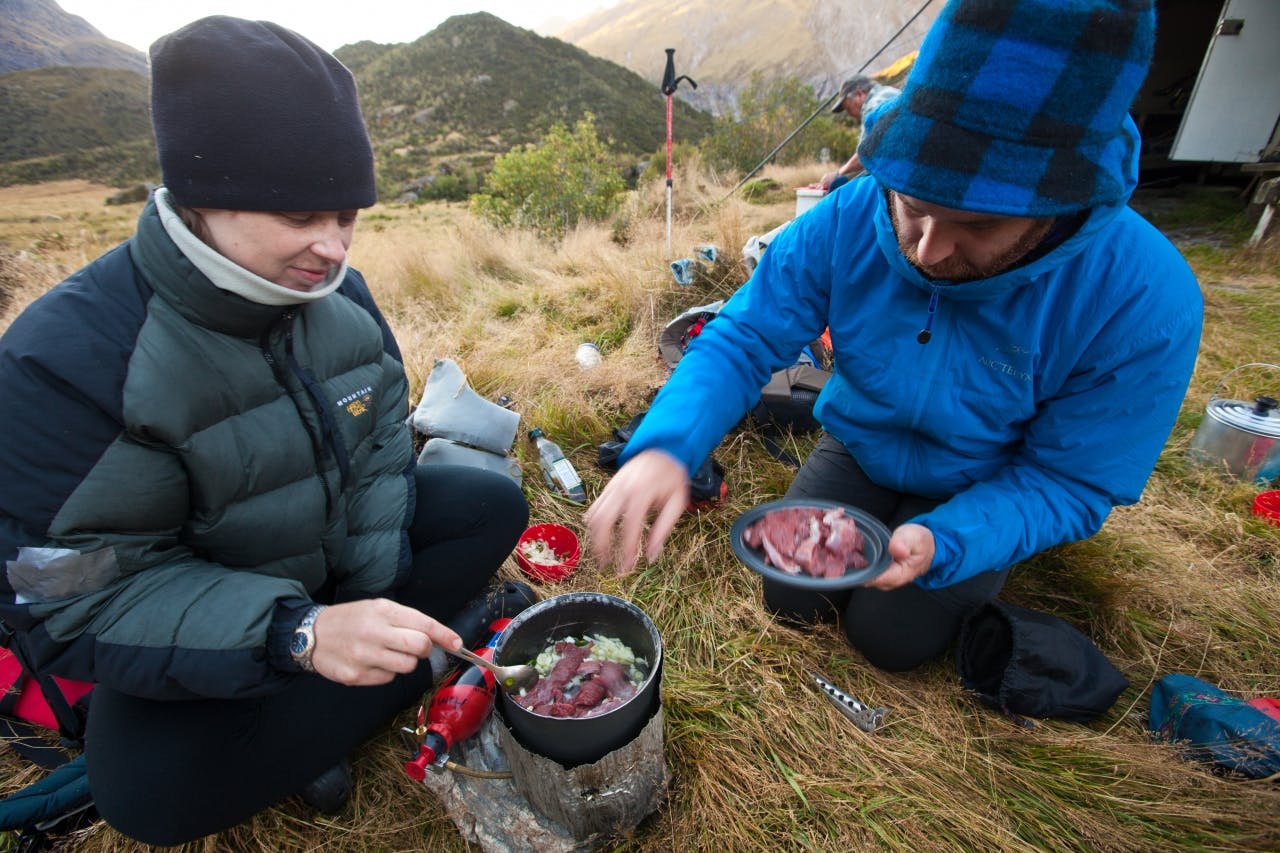
Though high in protein – and delicious – lean meat like chamois won’t provide as much fuel for hard multi-day tramps as high-fat meats like salami. Photo: Mark Watson
Nuts are a great source of fats and they also have some protein as well, which makes them a perfect all-rounder for snacks and as additives to breakfasts, dinners and desserts. Other fats to think about include chocolate and salami, and a bit of oil, cheese, or even butter, will go a long way to improve the flavour and filling power of a meal. Some dried parmesan can really lift a risotto or pasta dish.
Carbohydrates provide energy fast enough to power high intensity activity. They also feed the brain and help the body to burn fat stores efficiently. Carbohydrate stores are the most limited in our bodies and need to be regularly refilled. If you don’t take enough carbs on board, your body will turn to burning through protein stores instead, which is less than ideal.
When it comes to carbohydrates there is lots of choice from simple sugars, like lollies, to more complex carbs like fruits, vegetables and grains. Simple sugars will give an instant energy hit, but you may find your energy levels crashing an hour later. While complex carbs are broken down more slowly and trickle into the blood stream.
Dried fruits and vegetables are supermarket staples these days, and investing in a dehydrator will give you an even wider range.
Rice, pasta and noodles have always been popular, but there are a lot of other fast cook grains to experiment with. The ancient South American grain quinoa has a high energy-to-weight ratio and is also high in protein. Millet cooks in just five minutes and makes a nice change to oats or rice, and burghul wheat is another quick-cook grain.
Newer manufacturing processes have also allowed the production of foods such as flaked rice, which is brown rice that has been pre-cooked and rolled, and simply needs boiling water added to it. Garland has experimented with lots of fast, easy and nutritious desserts using flaked brown rice or flaked quinoa.
It’s interesting to note that powdered mashed potato, a mainstay of many Kiwi trampers, has just a third of the energy of other foods such as noodles, couscous and rice. This means you have to carry three times the weight of powdered mash to get the same amount of energy.
Another popular Kiwi tramping staple is porridge, but when you look at what you’re actually eating it’s nothing more than half a cup of oats and a cup of water. Little wonder that an hour down the track you’re starving again.
Porridge is a lovely, warming tramping breakfast, but try adding a spoonful of whole milk powder and another of LSA (a pre-bought mixture of ground linseeds, sunflower seeds and almonds) to each day’s serve, and then add a yummy topping of dried fruit that has been soaked and rehydrated overnight. Now you have a powerhouse breakfast that will get you out the door and a long way down the track before you need to refuel.
Associate professor Dr Nancy Rehrer, from University of Otago School of Physical Education and Department of Human Nutrition, says trampers can use the science behind physical activity and nutrition to give general guidelines for food intake, but people also need to be realistic and practical.
“No matter how nutritious something is, if you don’t like it you won’t eat it.”
Of course that doesn’t mean you can’t try new ideas. Testing new foods at home, before you are five days away from the nearest supermarket can be a wise move.
Aside from food, fluid intake is also “terribly important”, Dr Rehrer, herself a keen downhill mountain biker and former elite marathon runner.
A person’s ability to exercise is quite dependant on their circulation, in which blood volume plays a role. When a person is dehydrated, their plasma volume can drop and the heart has to work harder to pump blood around the body.
Studies on elite long-distance athletes show that sodium plays an important role in rehydration. When people sweat for hours on end, they don’t just lose water, but sodium as well. If a person is just drinking water and not taking in any sodium, they won’t fully rehydrate.
Generally, most of us get more sodium than necessary in our daily diet, but during long-lasting exercise you may be losing more than you are taking in. Things like instant soup packets are great for tramping as they help replace sodium. Salty snacks and adding extra salt to meals prepared at the end of the day can all help rehydration.
Trampers who are not stopping much along the way to eat could think about adding sodium to their drink bottle, although you certainly don’t want to add so much salt as to make it unpalatable.
As Garland says, when you spend long days walking, you tend to spend a lot of time thinking about what’s for tea, so it is important to have some variety.
Tramping food’s dull reputation is only made that way by a lack of imagination. Herbs and spices can be carried in small plastic bags. Keep an eye out for dried, or vacuum packed goodies in the supermarket. The international aisle and Asian grocery stores are well worth checking for the likes of dried shrimps, anchovies and mushrooms.
A quick look through Garland’s Fast and Light cookbook shows that sometimes all that is needed is a bit of thought about how to modify your favourite meals so you can reproduce them in a billy on a gas stove. After all, Garland’s sage and lemon chicken with rice, Moroccan fruit and nut risotto, beef minestrone and mango and coconut rice all sound tempting enough to cook up at home for dinner tonight.
‘You have no idea of the rubbish people eat. They live on noodles, couscous and packets of soup. Then they moan they’re so tired they can hardly move from one hut to the next.’ – Paul Garland
When it comes to tramping, low fat, low sugar and low salt foods are definitely off the menu
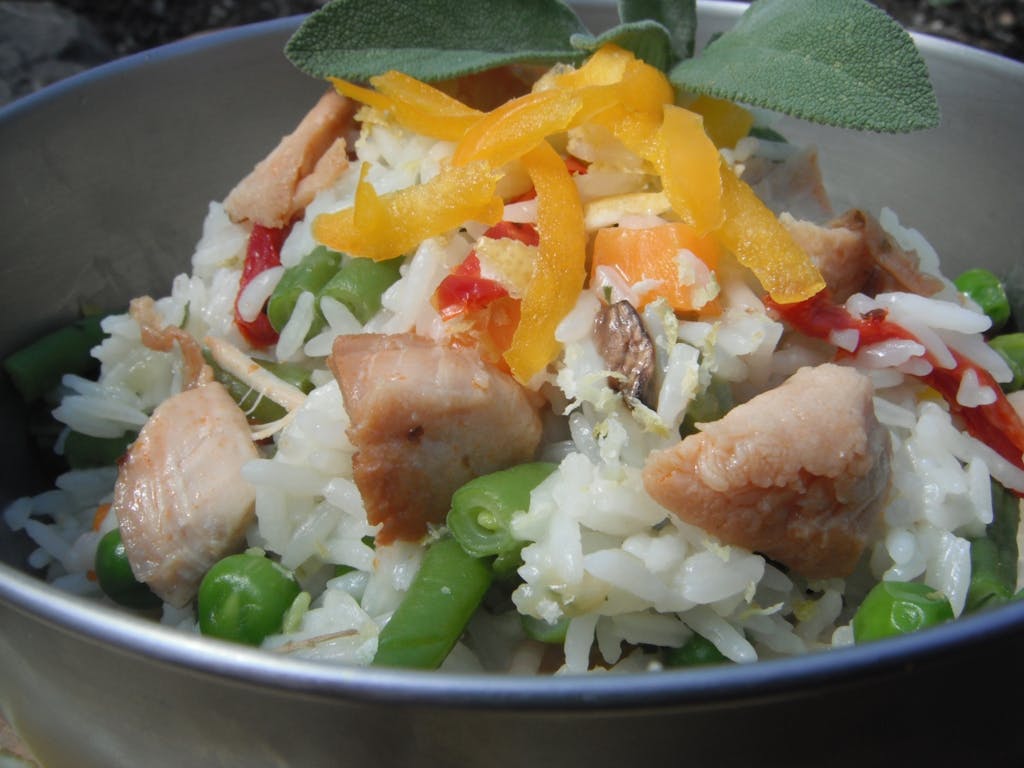
Sage and lemon chicken. Photo: Paul Garland
Gourmet and nutritious
Paul Garland’s recipe for sage and lemon chicken
Ingredients
½ cup par-boiled brown rice
¼ cup dried vegetables – carrots/corn/peas
¼ cup dehydrated chicken (or tinned lemon chicken)
2 tablespoon dried tomato
1 tablespoon dried onion
½ teaspoon dried garlic
1 teaspoon dried sage
1 chicken stock cube
small plastic bag of lemon zest
(dry weight 155g)
Method
Add 1 cup warm water into the plastic bag of dry mix and stand aside for 10 minutes to re-hydrate.
Add the re-hydrated mix to the rice and bring to a slow simmer. Stir frequently. Add more warm water, a little at a time, as the rice absorbs the liquid. Cook the rice for about 6-8 minutes or until tender.
– Recipe courtesy of Paul Garland , campfirecreations.co.nz





